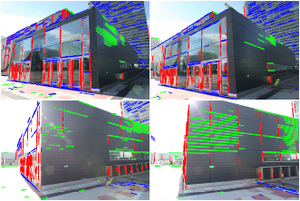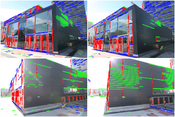Information
- Publication Type: Master Thesis
- Workgroup(s)/Project(s):
- Date: September 2010
- TU Wien Library:
- Diploma Examination: 28. September 2010
- First Supervisor:
Abstract
The realization that we see lines we know to be parallel in space as lines that appear to converge in a corresponding vanishing point has led to techniques employed by artists to render a credible impression of perspective. More recently, it has also led to techniques for recovering information embedded in images—or, indeed, in paintings that feature correct perspective—concerning the geometry of their underlying scene. In this thesis, we explore the extraction of vanishing points in the aim of facilitating the reconstruction of urban scenes. In departure from most vanishing point extraction methods, ours extracts a constellation of vanishing points across multiple views rather than in a single image alone. By making use of a strong orthogonality criterion per view, optimal segment intersection estimation and a novel tripod fitting technique, our approach allows for the extraction of results that correspond closely to the dominant three pairwise-orthogonal orientations of a typical urban scene. Accordingly, ours can fairly be described as a material refinement of the approach proposed in Sinha et al.Additional Files and Images
Weblinks
No further information available.BibTeX
@mastersthesis{hornacek-2010-evp,
title = "Extracting Vanishing Points across Multiple Views",
author = "Michael Horn\'{a}\v{c}ek",
year = "2010",
abstract = "The realization that we see lines we know to be parallel in
space as lines that appear to converge in a corresponding
vanishing point has led to techniques employed by artists to
render a credible impression of perspective. More recently,
it has also led to techniques for recovering information
embedded in images—or, indeed, in paintings that feature
correct perspective—concerning the geometry of their
underlying scene. In this thesis, we explore the extraction
of vanishing points in the aim of facilitating the
reconstruction of urban scenes. In departure from most
vanishing point extraction methods, ours extracts a
constellation of vanishing points across multiple views
rather than in a single image alone. By making use of a
strong orthogonality criterion per view, optimal segment
intersection estimation and a novel tripod fitting
technique, our approach allows for the extraction of results
that correspond closely to the dominant three
pairwise-orthogonal orientations of a typical urban scene.
Accordingly, ours can fairly be described as a material
refinement of the approach proposed in Sinha et al.",
month = sep,
address = "Favoritenstrasse 9-11/E193-02, A-1040 Vienna, Austria",
school = "Institute of Computer Graphics and Algorithms, Vienna
University of Technology ",
URL = "https://www.cg.tuwien.ac.at/research/publications/2010/hornacek-2010-evp/",
}

 paper
paper


